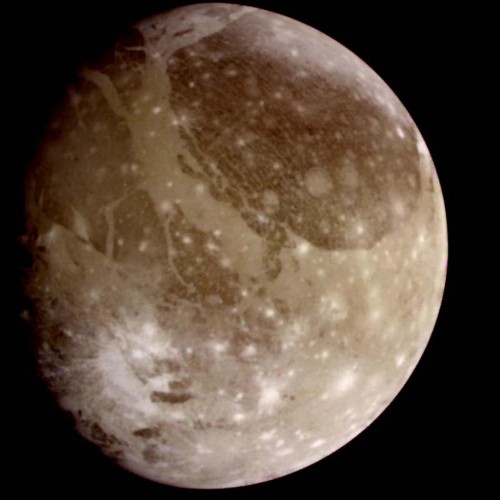The bulge is approximately 375 miles wide and nearly two miles tall, io9 said on Friday, and its cause and purpose currently have astronomers puzzled. Paul Schenk, a planetary scientist at the Lunar and Planetary Institute in Houston, said he came across the feature by accident.
Schenk, who reported his findings at the Lunar and Planetary Science Conference on March 20, explained to National Geographic that he was attempting to complete the global mapping of the moon's surface when he spotted the lump, which appears to be made out of thick ice.
The feature suggests that at one time, Ganymede's icy shell rotated atop the rest of the moon. Schenk believes that the bulge began growing at one of the poles, and then moved into a different position once its mass grew large enough. The shell slid atop the ocean, while the interior of the moon stayed in the same orientation, causing it to wind up at the equator.
"The only place you can get a large mass like that - that's not related to geology that we know of - is at the cold poles," he explained. Since the poles are "permanently cold," it would result in a "significant amount of thickening of the ice shell," the planetary scientist added.
The phenomenon is known as true polar wander and is comparable to the Earth's Arctic region moving to the Equator while everything beneath the crust stayed in place, Nat Geo said. It can only occur when a fluid body such as a global ocean separates the rind of a moon from its inner parts, or else the crust would be unable to slide atop the rest of the moon.
If the bulge formed at one of Ganymede's poles, and if polar wander explains why it is currently located at the moon's equator, scientists expect that there will be a similar feature opposite this one. Schenk said that they hope to confirm that when the next spacecraft arrives at the moon, but he and his colleagues remain uncertain exactly why the bulge still exists at all.
Okay...but what is it?
"Any ideas about how you support a three-kilometer-high [two-mile] ice bulge, hundreds of kilometers wide, over the long term on Ganymede are welcome," Bill McKinnon of Washington University in St. Louis, who worked with Schenk on the observations, told Nat Geo. "We've never seen anything like it before; we don't know what it is."
Comment: What if it isn't long-term? What if it only formed recently?
Schenk and McKinnon first spotted the bulge in images taken by the Galileo spacecraft while searching for a different type of feature - "crop circles," or deep, concentric grooves in icy shells that are created by the strain of the shell rotating. Crop circles found on Europa suggests that that moon also experienced true polar wander occurred there, and that just like on Ganymede, the poles of the moon are approximately 90 degrees offset from their original location.
Both Jovian moons have subsurface global oceans, which Nat Geo explains is a prerequisite for a wandering icy shell. If Ganymede's crust actually did move, Robert Pappalardo of NASA's Jet Propulsion Laboratory said that it could help explain what has controlled the orientations of all of the moon's grooves.
"If they all shifted and flipped over by 90 degrees, then we've been looking at the wrong orientation to try to understand what formed the grooves. So that's exciting," he said. The discovery comes just a few weeks after researchers confirmed the presence of buried ocean on Ganymede by studying auroras on the moon.




NASA?? Nat Geo??
The folks who brought you the fake moon landing and this magazine cover: [Link]
?????
Consider the source.
Nearly every NASA photo and story is faked to keep the followers of Scientism buried in some rabbit hole.